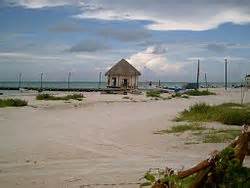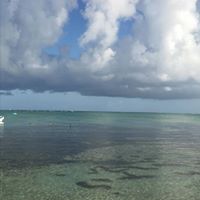Where are the best beaches in and around Yucatan: Riviera Maya, Playa del Carmen, Cancun, Merida, etc?
Denis Larsen - Casa Hamaca Guesthouse
 Most people like the beaches in Tulum. Just north of Tulum is Akumal. North of Akumal is Playa Del Carmen, which is to my mind like going to Coney Island on a July day; I would avoid it at all cost.
Most people like the beaches in Tulum. Just north of Tulum is Akumal. North of Akumal is Playa Del Carmen, which is to my mind like going to Coney Island on a July day; I would avoid it at all cost.There are beautiful beaches on Isla Mujeres, which is a small island just off of Cancun. The beach in Puerto Morelos is a very nice beach.
Working your way up the peninsula on the Caribbean side, when you get up where the Caribbean meets the Gulf, there is an island...
 Most people like the beaches in Tulum. Just north of Tulum is Akumal. North of Akumal is Playa Del Carmen, which is to my mind like going to Coney Island on a July day; I would avoid it at all cost.
Most people like the beaches in Tulum. Just north of Tulum is Akumal. North of Akumal is Playa Del Carmen, which is to my mind like going to Coney Island on a July day; I would avoid it at all cost.There are beautiful beaches on Isla Mujeres, which is a small island just off of Cancun. The beach in Puerto Morelos is a very nice beach.
Working your way up the peninsula on the Caribbean side, when you get up where the Caribbean meets the Gulf, there is an island called Isla Holbox which is 45 kilometers (about 28 miles) of sand; a new road just went in to that town and in two or three years it will change drastically.
Along the whole north coast of the Yucatan peninsula from Holbox almost over to Celestun in Chuburna Puerto are very nice beaches. Property was inexpensive in some of those towns. I don’t know where it is now. That’s where I was doing the volunteer work when I first came down here and we were offered what would almost be a villa two blocks off the water for almost $24,000. It needed some work, but I suspect I would have just gone up in value.
Tulum is mostly known for two things – ashrams and hippies, both of which have been going there probably since the 60s. There is a Mayan ruin there that’s not a particularly great Mayan ruin but its’ setting is just absolutely magnificent. It is sitting right on the edge of a cliff overlooking the Caribbean. That was the draw. Now it is become very popular, chic. Apparently there are a lot of hipsters now, a lot of restaurants. It is gentrified in many ways. The hippies and the ashrams are still there, but they’re a little harder to find now.
“Akumal” means “place of the turtles.” Turtles come in there to lay their eggs and then the baby turtles, when they hatch, find their way to the water, so all the hotels along there have signs, “Don’t leave your lights on at night,” because the turtles, when they hatch, look for the moon shining on the water and try to go whatever way that happens to be. If you got a bright light on they’re going to think that’s where they’re supposed to go.
Working up, there is Playa Del Carmen. In 1977, it had a couple of hundred people living there full-time and now probably, wild guess, maybe 100,000 to 200,000. It is a place I don’t go, so I don’t know; I avoid it. Up until a few years ago, the fastest growing town in Mexico was Merida and now Tulum is second in that position. Every time that happens, whether it is a gold rush, a land rush, or whatever kind of rush, the character of the place changes very, very rapidly. People come from all over Mexico, all over the world, some with good intentions, some with less good intentions.
Isla Mujeres, “Island of the Women” is called that, at least in one of the stories, because the ruin at the southern end of the Mayan ruin on the island had, I believe, seven clay or stone dolls that were women. Both Isla Mujeres and Cozumel were semi-sacred sites to the Mayans, who made pilgrimages once a year or more to partake in ceremonies. I think it is 8 kilometers (about 5 miles) long and in some places not much more than a 100 meters wide. From the east of Isla Mujeres you can see all of Cancun.
Puerto Morelos is just north of Playa Del Carmen. It was, at one point, a fairly bustling fishing and shipping town, but it seems to have lost a lot of that character. Now it is a place where a lot of locals from here go when they want to go to the beach because it is low- key. It does not have a Miami Beach or Las Vegas atmosphere.
Isla Holbox is made from two Mayan words: “hole,” which happens to be the same word in English and “box,” which means “black,” so it is a black hole. There are freshwater cenotes coming up in the ocean, in the backwater of the island. In Florida, they call cenotes “sinkholes.” You can pass from an area where there are saltwater fish to a freshwater area, where you have freshwater fish, and then a few minutes pass over to that again; it is a very interesting phenomena. The area is known for fishing, but now it is known for swimming with the whales. Other than that (I’ve been up there twice), if you don’t fish or suntan, I don’t think there is a lot to do.
Cenotes are the only source of fresh water in the whole northern Yucatan Peninsula. Many of them are interconnected underground. Some people think they’re all interconnected. Virtually every town that exists has a cenote because that’s the only source of water, so that’s where they built the town. In the state of Yucatan, there are around 3,000 something registered cenotes and perhaps as many as 10,000.
It’s a very interesting phenomenon. People use them to swim. There is one that you can kayak on, although you’ll kind of go in circles. One of the big draws for tourists is the cenotes that are buried; some of them are underground domes with a small hole to the sky where the birds, light, and butterflies can come in. They are mostly, in this area, 30 meters (about 100 feet) below land level, varying with the contour of the land. You can go down into the water in the cenote. Sometimes people build a stairway or ramp to get down there.
Chuburna Puerto and Chuburna Pueblo were the same town at one point, I guess, but now they have Chuburna Puerto, which is on the water, the port, and Chuburna Pueblo, which is quite a ways inland, but they have the same name, so at one point they were attached to each other. I know other places up there that are similar: the puerto is on the water and the pueblo is inland. That’s very close to Merida.
Merida has some beaches at Progreso which are very popular and that are close enough that on a weekend anybody in Merida who has a car or gets on a bus, wants to go to the beach. Progreso is the main draw. Up until it became a cruise ship stop, actually now it is a cruise ship port, it was just a quiet, calm, little sleepy village. Now, three times a week, I think, they have 2,000 people show up for 8 hours and buy all kinds of stuff that nobody needs. It has changed the character of the town very much. It has been a big economic benefit to some people in town but it changed the town.
(Beach on the island of Isla Holbox, Yucatan, Mexico, pictured. )
Posted October 4, 2015
Paulina Almeida - Tao Real Estate
 In the state of Quintana Roo (includes Cancun, Cozumel, Playa del Carmen, Tulum, and here in Akumal, the best beaches are in Tulum. Tulum’s beaches have crystal clear waters and sand that is like powder. Tulum’s beaches are amazing. For kilometers, you’ll only see the white sand and the crystal-clear water.
In the state of Quintana Roo (includes Cancun, Cozumel, Playa del Carmen, Tulum, and here in Akumal, the best beaches are in Tulum. Tulum’s beaches have crystal clear waters and sand that is like powder. Tulum’s beaches are amazing. For kilometers, you’ll only see the white sand and the crystal-clear water. If you go south of Tulum you will see that there are still parts of the beach that are untouched. These virgin beaches are...
 In the state of Quintana Roo (includes Cancun, Cozumel, Playa del Carmen, Tulum, and here in Akumal, the best beaches are in Tulum. Tulum’s beaches have crystal clear waters and sand that is like powder. Tulum’s beaches are amazing. For kilometers, you’ll only see the white sand and the crystal-clear water.
In the state of Quintana Roo (includes Cancun, Cozumel, Playa del Carmen, Tulum, and here in Akumal, the best beaches are in Tulum. Tulum’s beaches have crystal clear waters and sand that is like powder. Tulum’s beaches are amazing. For kilometers, you’ll only see the white sand and the crystal-clear water. If you go south of Tulum you will see that there are still parts of the beach that are untouched. These virgin beaches are amazing as they’ve kept the same white, powdery sand and the crystal blue water.
(Beach in Akumal Mexico, pictured.)
Posted April 3, 2017
Roddrigo Sidney Whalesharkdaddy - Cancun Whale Shark Tours
The beaches in the Yucatan either face the Gulf of Mexico (Progresso, Holbox, Isla Mujeres, etc.) or the Caribbean (Cancun, south through Puerto Morelos, Playa del Carmen, Puerto Aventuras, all the way to Tulum).
The Caribbean waters are a translucent turquoise blue, while the Gulf water are more green.
The beaches are all great, with the Gulf beaches being the safest, while there can be dangerous undertows in the Caribbean. Always be careful!!!!
The Caribbean waters are a translucent turquoise blue, while the Gulf water are more green.
The beaches are all great, with the Gulf beaches being the safest, while there can be dangerous undertows in the Caribbean. Always be careful!!!!
The beaches in the Yucatan either face the Gulf of Mexico (Progresso, Holbox, Isla Mujeres, etc.) or the Caribbean (Cancun, south through Puerto Morelos, Playa del Carmen, Puerto Aventuras, all the way to Tulum).
The Caribbean waters are a translucent turquoise blue, while the Gulf water are more green.
The beaches are all great, with the Gulf beaches being the safest, while there can be dangerous undertows in the Caribbean. Always be careful!!!!
The Caribbean waters are a translucent turquoise blue, while the Gulf water are more green.
The beaches are all great, with the Gulf beaches being the safest, while there can be dangerous undertows in the Caribbean. Always be careful!!!!
Posted March 12, 2018


